Friday, September 08, 2006
Monday August 21st through Thursday 24th – The Rest of Ireland
MONDAY, DUBLIN TO CORK
On Monday we got up and had breakfast at the hotel before we left on our journey to Cork. We had some discussion about the best way to drive to Cork. We finally decided that we would see the real country better if we got off the major highways and saw all the small towns and villages on the way. We left the hotel and got on the M50 Motorway which is Dublin’s Interstate 285. It rings Dublin just like I 285 does Atlanta. We got out after the morning rush and it did not take us long to get to the south end of the city and get out onto the secondary roads which ran along the coast of the Irish Sea.
We passed through small towns that looked like small towns anywhere.
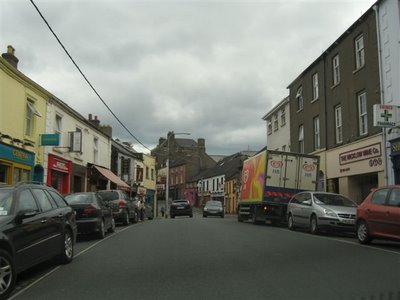
We also saw some buildings which you don’t see in a lot of small towns, unless you happen to be in a small town in Ireland.
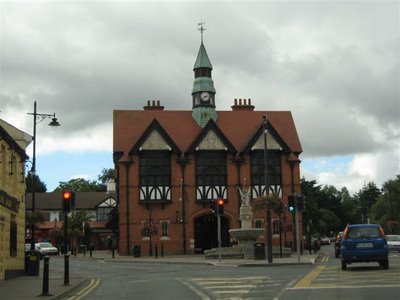
We saw a lot of local people and stopped and visited with some of them. You can learn a lot about the country doing this. The first place we stopped for any length of time for pictures was in a village named Greystones. They have a small harbor behind a sea wall which protects their bay.
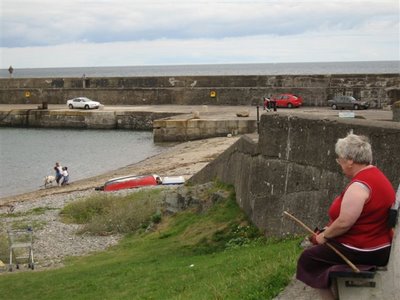
It appeared to be used mostly by fishing boats and sports and leisure boats.
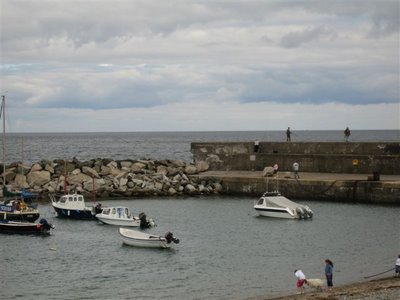
It was an active little town with a town square which had a monument to the men who went to sea.
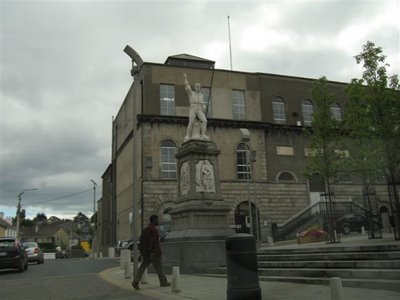
When we returned to the open road, we found a small diversion with a pretty area with a small golf course winding around a bay on some pretty extreme hills.
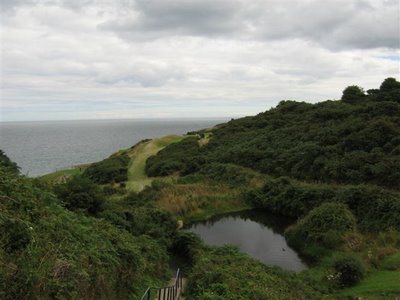
There was a walkway from the parking area which had several long sets of steps leading down to a rocky beach. It passed through the golf course and we actually went under a foot bridge which was used by the golfers to get from tee to green on a par three hole.
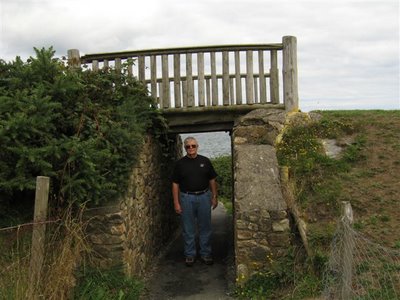
You know Mary and her trusty camera. We made friends with and photographed several of the golfers. I even got a picture of a beautiful mermaid sitting on a rock by the sea.
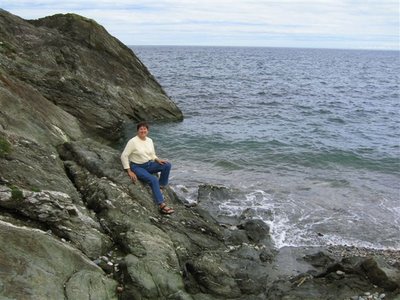
On the out skirts of the next village we found a very small, old church with a very large graveyard surrounding it.
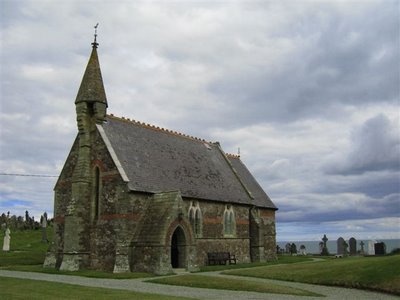
The graves in around the church were from the early 1800’s.
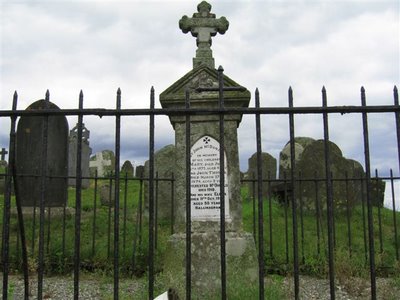
The newer section of the cemetery was farther up the hill. We pulled off the road and spent a few minutes just walking the hill and looking at the headstones. I didn’t see any Bradys, McBradys or O’Bradys. There may have been some.
It seemed that the farther we went the narrower the roads became and the higher the hedge row fences became. It got increasingly more difficult to drive and I was getting tired so the stops were more pleasant to me than they had been in the morning.
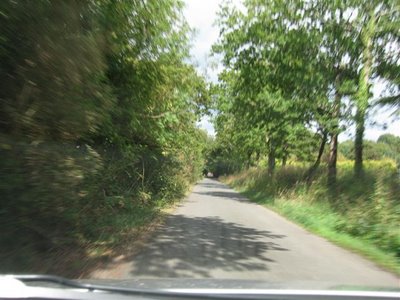
Just before we got to Wexford, we hit a bit of road which was so narrow that the trees overlapped over the road and made tunnels in some places. It was farm land with grain and hay mixed with dairy farms.

Some of the houses and farm buildings were very old and a lot of them had thatched roofs.
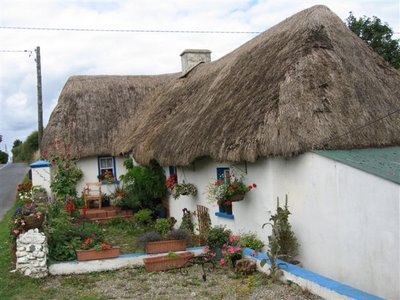
We thought it was all very Irish.
We took a good long break in Wexford. They have a large waterfront for such a small town. The tourist information office was out on the Quay in the Harbour.
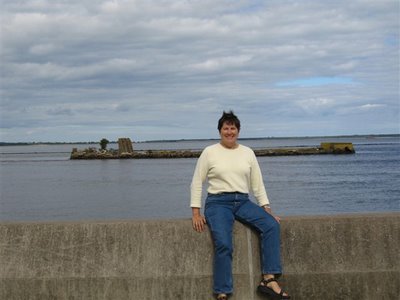
There was a large parking area on the quay, but it was all full so we drove on until we found parking on the street. We walked back down the waterfront to the tourist information office. On the way we passed a small Class C Motor Home parked on the Quay. There was an elderly couple sitting inside with a window open. I stopped and went back and Mary came over with me. I knocked on the wall and we introduced ourselves. They were just sitting there having a beer in the mid afternoon.
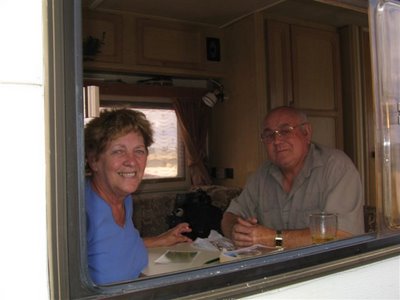
We had a very nice visit through their kitchen window. We told them about full time RV’ing . They are from England and came over on the ferry to spend a few weeks on holiday in Ireland. The guy said they didn’t like caravan parks, which they call RV Parks, so they just found large public parking areas to camp. We noticed this all over Europe; campers would be pulled off just in wide spots beside the road, or in closed service stations.
We walked around the town for a while and there are a couple of things of note. First there was a potato market on the front street.
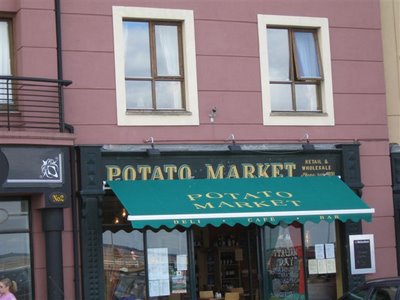
I was glad to see that. We even saw several farms which appeared to have fairly large potato fields. They did not compare to the number of potato farms we saw in Idaho. Of course, Ireland is probably not as large as Idaho. There was also an impressive statue of the Quay honoring Commodore John Barry.
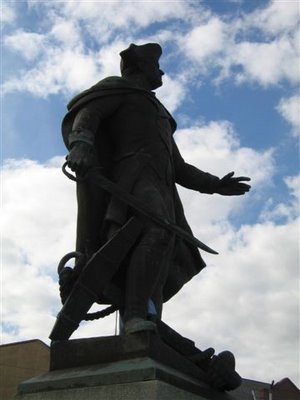
In 1776 Barry commanded the first American Navy vessel to capture a British ship. In 1783 Barry’s ship fired the last shot by a warship in the Revolutionary War. From 1794 until he died in 1803 he was the Senior Commodore of the US Navy. The monument was presented by the United States in 1956 to honor the contributions which Barry, a native of Wexford, made to the US Navy. On the way out of town we passed a business of one of the family, possibly!!

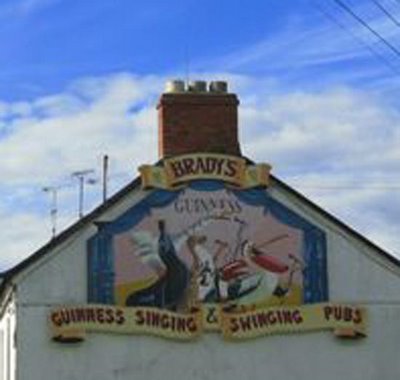
We passed through Waterford late in the afternoon. It is not a large city, but it is very pretty. The streets are built like many European towns, all crowded and curved. We passed Yeats College,
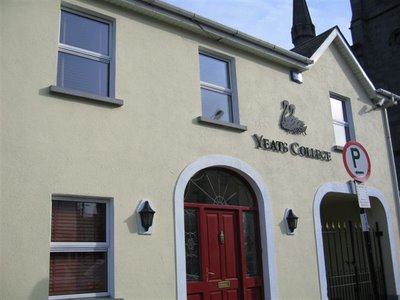
and the Waterford Crystal Plants.
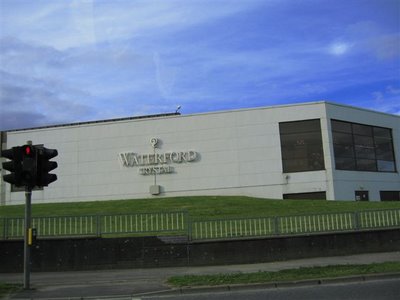
There is a Castle in Waterford which we had considered as an overnight spot, but it was a little costly so we changed our mind. From Waterford on toward Cork the countryside became increasingly more scenic. Just outside Waterford we came to the small port town of Dungarvan. It was getting near dark and we stopped here for a traditional Irish dinner at McDonalds before we rushed on to Cork. It was almost too late for pictures, but we stopped up on top of a hill and Mary took some pictures back into a valley and got Dungarvan, the Bay and the Irish Sea.

MONDAY, DUBLIN TO CORK
On Monday we got up and had breakfast at the hotel before we left on our journey to Cork. We had some discussion about the best way to drive to Cork. We finally decided that we would see the real country better if we got off the major highways and saw all the small towns and villages on the way. We left the hotel and got on the M50 Motorway which is Dublin’s Interstate 285. It rings Dublin just like I 285 does Atlanta. We got out after the morning rush and it did not take us long to get to the south end of the city and get out onto the secondary roads which ran along the coast of the Irish Sea.
We passed through small towns that looked like small towns anywhere.

We also saw some buildings which you don’t see in a lot of small towns, unless you happen to be in a small town in Ireland.

We saw a lot of local people and stopped and visited with some of them. You can learn a lot about the country doing this. The first place we stopped for any length of time for pictures was in a village named Greystones. They have a small harbor behind a sea wall which protects their bay.

It appeared to be used mostly by fishing boats and sports and leisure boats.

It was an active little town with a town square which had a monument to the men who went to sea.

When we returned to the open road, we found a small diversion with a pretty area with a small golf course winding around a bay on some pretty extreme hills.

There was a walkway from the parking area which had several long sets of steps leading down to a rocky beach. It passed through the golf course and we actually went under a foot bridge which was used by the golfers to get from tee to green on a par three hole.

You know Mary and her trusty camera. We made friends with and photographed several of the golfers. I even got a picture of a beautiful mermaid sitting on a rock by the sea.

On the out skirts of the next village we found a very small, old church with a very large graveyard surrounding it.

The graves in around the church were from the early 1800’s.

The newer section of the cemetery was farther up the hill. We pulled off the road and spent a few minutes just walking the hill and looking at the headstones. I didn’t see any Bradys, McBradys or O’Bradys. There may have been some.
It seemed that the farther we went the narrower the roads became and the higher the hedge row fences became. It got increasingly more difficult to drive and I was getting tired so the stops were more pleasant to me than they had been in the morning.

Just before we got to Wexford, we hit a bit of road which was so narrow that the trees overlapped over the road and made tunnels in some places. It was farm land with grain and hay mixed with dairy farms.

Some of the houses and farm buildings were very old and a lot of them had thatched roofs.

We thought it was all very Irish.
We took a good long break in Wexford. They have a large waterfront for such a small town. The tourist information office was out on the Quay in the Harbour.

There was a large parking area on the quay, but it was all full so we drove on until we found parking on the street. We walked back down the waterfront to the tourist information office. On the way we passed a small Class C Motor Home parked on the Quay. There was an elderly couple sitting inside with a window open. I stopped and went back and Mary came over with me. I knocked on the wall and we introduced ourselves. They were just sitting there having a beer in the mid afternoon.

We had a very nice visit through their kitchen window. We told them about full time RV’ing . They are from England and came over on the ferry to spend a few weeks on holiday in Ireland. The guy said they didn’t like caravan parks, which they call RV Parks, so they just found large public parking areas to camp. We noticed this all over Europe; campers would be pulled off just in wide spots beside the road, or in closed service stations.
We walked around the town for a while and there are a couple of things of note. First there was a potato market on the front street.

I was glad to see that. We even saw several farms which appeared to have fairly large potato fields. They did not compare to the number of potato farms we saw in Idaho. Of course, Ireland is probably not as large as Idaho. There was also an impressive statue of the Quay honoring Commodore John Barry.

In 1776 Barry commanded the first American Navy vessel to capture a British ship. In 1783 Barry’s ship fired the last shot by a warship in the Revolutionary War. From 1794 until he died in 1803 he was the Senior Commodore of the US Navy. The monument was presented by the United States in 1956 to honor the contributions which Barry, a native of Wexford, made to the US Navy. On the way out of town we passed a business of one of the family, possibly!!


We passed through Waterford late in the afternoon. It is not a large city, but it is very pretty. The streets are built like many European towns, all crowded and curved. We passed Yeats College,

and the Waterford Crystal Plants.

There is a Castle in Waterford which we had considered as an overnight spot, but it was a little costly so we changed our mind. From Waterford on toward Cork the countryside became increasingly more scenic. Just outside Waterford we came to the small port town of Dungarvan. It was getting near dark and we stopped here for a traditional Irish dinner at McDonalds before we rushed on to Cork. It was almost too late for pictures, but we stopped up on top of a hill and Mary took some pictures back into a valley and got Dungarvan, the Bay and the Irish Sea.
